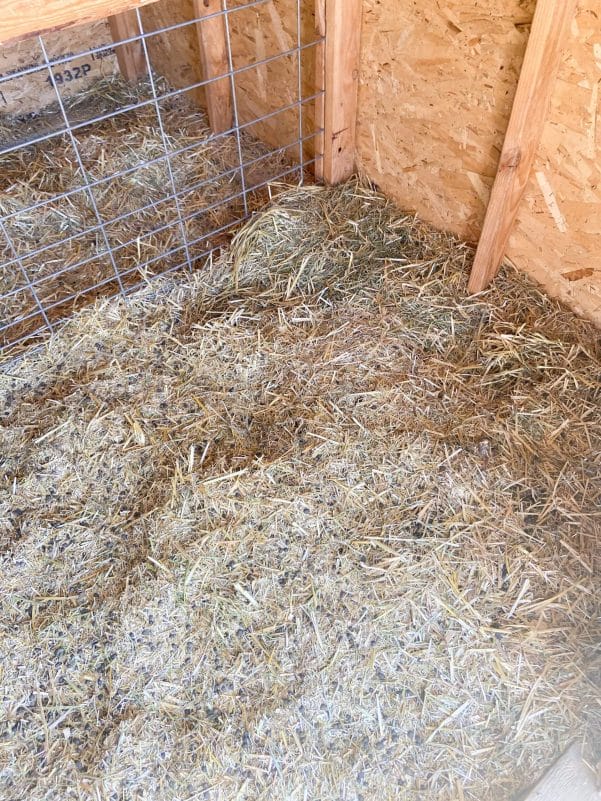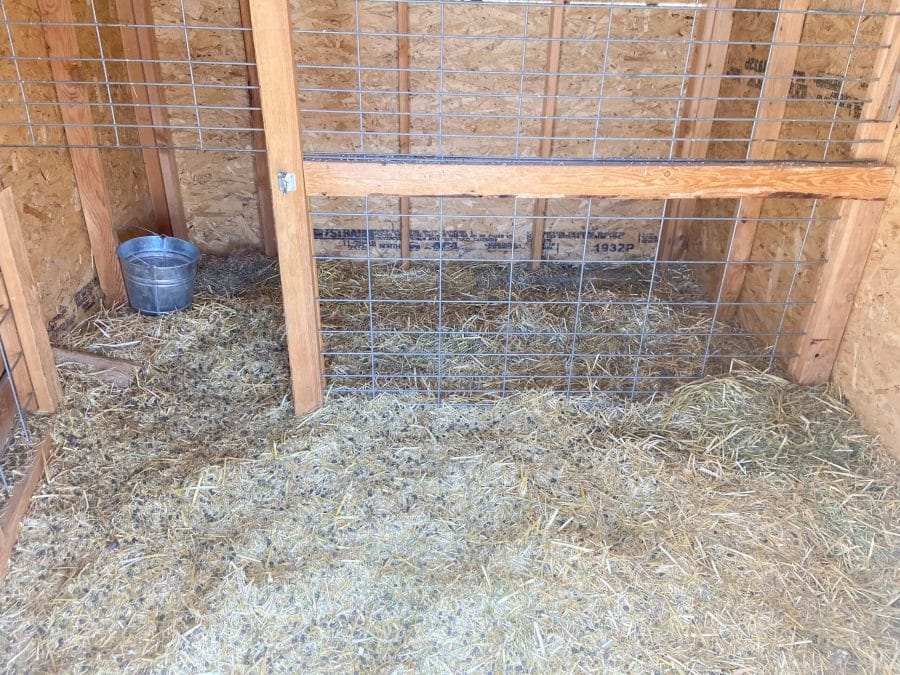How We Use the Deep Litter Method with Our Goats and Chickens To Keep Them Warm
Want to learn about how to use the deep litter method keep your farm animals warm in the winter? How about also being able to benefit by using this in the spring in your garden. This method helps keep chickens warm and keep goats warm by increasing body heat, good ventilation, and by using simple straw bales as your main go to. I am sharing actionable tips that will help you maintain a happy flock of healthy chickens or herd of goats without using external heat sources during those cold winter temperatures.

When we first started our venture into owning farm animals, the city girl in my had a bit of a panic. I worried about how these little creatures could possibly stay warm in the winter months where we lived. My husband always looked at my like I had two heads. He’d say, I grew up with chickens and never had an issue with them staying warm in the winter. The first winter I worried about my chickens and goats and checked on them often. Through wet weather and single digits, my chickens were happy and healthy.
Do you want to know how? First let’s talk about exterior heat sources. There are so many ways to keep your flock of chickens or herd of goats warm. But, as well looked into them, we decided they were not going to work for us. One thing specifically, adding some source of heat to the chicken coop seemed a bit dangerous. It also could create a bigger problem with the chickens. They could become dependent on the source of heat. If you had a power outage, they would not recover well from the drastic changing temperatures.
Keeping chickens warm does not need not be complicated. You can keep them warm on cold nights without a direct heat source!
There are a couple things to consider when planning to keep your chicken and goats warm:
New chicken owners may run out to purchase additional heat sources, such as an electric heater or heated light bulb, but you do not need it.
Address these issues before adding any additional heat sources to your chicken coop:
- Good ventilation– this may be confusing because you do not want to have cold wind blowing though the coop, but there needs to be adequate ventilation. We have some areas at the top of the coop that we intentionally left a space open so that there was ventilation. You can also put plastic sheeting over the windows to keep drafts out.
- Extra insulation– on the bulk of the coop we made sure to use expandable insulation to fill any holes or gaps to prevent drafts from entering the coop. There is a difference between ventilation and drafts.
- Extra scratch grains– this is a great idea to give the chickens in the evening prior to going to their roosting bars, the extra scratch will digest through the night to give them extra body warmth.
- Pine shavings or wood chips- this is the primary material we use other than straw bales. Do not use cedar shavings, as this can cause respiratory issues.
- Avoid a lot of moisture – this can cause respiratory problems as well. Do not keep the chicken’s water in the coop and make sure that the coop is a dry space. Eliminate any leaks or areas where moisture is coming in. This is why having proper ventilation is important. If you do not have proper ventilation, you will have moisture issues and during the colder months this can be dangerous for your chickens health.
- Using electric heat sources can be a fire risk. Make sure to think about this, many coop and barn fires happen every year and the source is almost always from a supplemental heat source such as traditional heat lamps.
- Deep Litter Method (I will explain this more below)
- Also remember chickens slow down their egg production in the winter, not because of the cold as much as from the lack of daylight. They need a certain amount of light to lay their eggs.
- Chickens will also usually molt in the fall which gives them new feathers, which will help them in the winter. If you have seen a chicken in their coop on their roost bars in the winter, they fluff up their feathers and trap the warm in inside. They have wonderful ways of keeping themselves warm. Also, chickens huddle together to increase their body temperatures, so having a larger flock is good.
- You can also add warm water to their waterer to keep them warm through the day. I have heard this also helps keep them laying, however I do not have hard evidence myself.
Things to think about how to keep goats warm:
- The main thing you want to think about to keep your goats warm on those cold winter nights is to have a wind break or lean to to block those harsh winds.
- Try to keep the area dry with a source of food.
- Feeding them grain or oats in the evening will allow their digestive system to work though the night, keeping their body temperature up.
- Use the deep litter method to keep them comfortable and happy.
The bottom line with goats is that you really do not have to do much as they are hearty animals that grow a thick winter coat and can handle the colder weather. I choose to give them a bit more comfort and this is why I am addressing this.
Chickens and goats are hearty creatures, and I have found ours to be thriving even in the most bitter temperatures we have here. Funny enough, the goats will go hide out in our goat house if they do not approve of the weather outside. They especially do not like being wet and go inside to avoid rain and snow. I don’t blame them a bit.
My chickens seem to be happy pecking and scratching along in the snow and colder temperatures. They are often out in the chicken run on sunny days happily foraging in winter weather.
When we decided to get goats and chickens I knew I wanted to be prepared and give them a good and happy life that was comfortable without being high maintenance. That is where the Deep Litter Method came into play on our farm.
I have read a lot on this method of keeping your animals warm. I knew it was our best bet to keep ours happy and keep their body temperature up during the cold winter months.
The Deep Litter Method is basically giving yourself a compost pile right on the chicken coop or barn floor. You use layers upon layers of organic material(such as hay or wood shavings) as well as the addition of pee and manure from the animals. As the layer you put down gets loaded with manure, you add another layer of straw or wood shavings. As you continue to add more layers, the layers underneath begin to decompose and actually create a source of heat.
We use the deep litter method in both our goat house and our winter chicken coop.
How do we use the deep litter method to keep our chickens warm and our goats too?
We actually start the deep litter method way back in the fall. This is the first step. Before temperatures plummet to frigid digits, we give the floor of the coop and goat house a deep cleaning. We remove all bedding and add a dusting of Diatomaceous Earth to the ground. We then add a thick layer of straw or wood shavings. I prefer to use wood shavings in our chicken coop and straw in the goat house. We have found this to work for us.
As the winter progresses, instead of removing the bedding, like I would in the hot summer months, I add a thin layer of bedding on top of the old bedding. This keeps the smell down and begins the deep litter activity.
I keep doing this until the bedding gets so deep I actually need to remove some. I just did this in the chicken coop a couple weeks ago. And it was very rewarding.
I will tell you, this deep litter bedding is solid gold in the garden!
As the bedding gets more layers added onto it, the layers underneath begin to compost. You are basically giving yourself a compost pile without having to do anything!
I cleaned my chicken coop about 2 weeks ago and all the product from their deep litter bedding ended up in my garden boxes. I did the same thing in the fall and added it to the garden area before covering with straw. That dirt is now getting rich and everything is composting beautifully.
I basically have an endless supply of compost at my disposal. My chickens and goats have a nice warm place to escape from the cold, and I get the winter off of mucking the coop and goat house. It is a win/win and I am so glad that we chose to do this for our animals.
What you need to know about deep litter method:
The most important thing to remember if you choose to do this for your animals is to make sure you are adding fresh bedding often. Its not good to let your chickens wallow in their chicken droppings, especially if it is building up over the winter. A good rule of thumb is to go by the smell and feel. Adding a thin layer of bedding will help keep the smells down, and the new litter will absorb any moisture or liquid in the bedding. It will keep it dry and clean for your animals. If you can smell the coop, its time to add more bedding. I like to add this to my nesting boxes as well because they will often spend time in there.
So, if you find that in your goat shed, or your chicken coop, you have some wet areas or you find the pop is beginning to add up, make sure to add another layer of straw or wood shavings.
I usually will add a small amount about every week or two, sometimes more, sometimes less. It really just depends on your animals, the weather, and how dry it is inside their shelter.

As you keep layering the straw or wood shavings, the layers underneath will begin to break down and they will actually put off warmth from the decomposition of the materials. It is a great way to keep your animals warm. Now, it wont feel like a heater but it will have some radiant heat that they will benefit from.
You can see in my goat house, that its is full of straw and goat poop. This is actually a pretty deep litter set up right now. I will add another layer from our bales of straw and then once it gets too thick, I will clean most of this out and put it all in my compost bin or straight into certain areas in my garden.
I find that if I use the deep litter method at the beginning of the winter, but about March we are ready to clean it out, and by this time, our weather is getting more mild. It’s a great time to clean it out.
Once the warm weather hits, I will make sure too clean out both the chicken coop and the goat house often to keep the smell down. The heat of the summer makes things heat up much faster. We do not use the deep litter method in the summer.
If you are new to all of this, and are thinking about getting chickens, I have some great posts for you:
My Functional And Eye Catching Chicken Coop Design
My Must Have Chicken Coop Supplies and Necessities
How to Choose the Right Chicken Breeds for Your Backyard
Amazingly Gorgeous and Stylish Chicken Coop Ideas
Everything You Need to Know About Raising Baby Chicks
